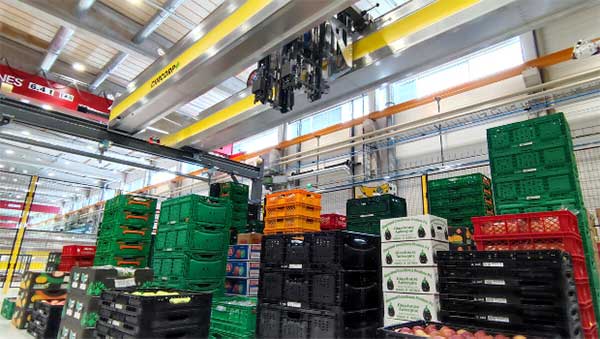Grocery retailers are turning to automation in droves. While automation isn’t new, it’s expanding into new areas, specifically fresh food.
For years, automation in warehouses and distribution centers has been seen as “the next big thing.” Now, what was once a dream is increasingly becoming a reality. Several factors have led to the increased adoption of automation. On the one hand, logistics leaders are driven by a desire to improve order fulfillment speed, efficiency, and accuracy. On the other hand, they see automation as a way to navigate the challenges of ongoing labor shortages and skyrocketing real estate prices.
As automation continues its rapid rise from a nice-to-have to a must-have, here are four trends to anticipate:
For the past few years, sustainability has been a major talking point in the industry. Now, it’s moving from boardrooms to kitchen table conversations. In fact, 57% of consumers are now willing to change purchasing habits based on the environmental impact of a product.
For grocery retailers, food waste is a major hurdle in their sustainability efforts. The longer it takes to get fresh and perishable food through the supply chain and to the store shelf, the higher likelihood of premature spoilage. Whether spoilage happens in the store or at a consumer’s home, it contributes to the big problem of food waste. Fortunately, automation can lend a helping hand. With automation, grocers can achieve rapid, accurate order fulfillment and increase shelf life, keeping profits up and waste down.
Warehousing space in North America is becoming increasingly scarce and expensive. In the first quarter of 2023, industrial vacancy in the U.S. sank to just 3.1%, well below the ten-year average of 5.3%. Meanwhile, industrial rent rose to $9.19 per square foot, marking the first time average prices were over $9 in US history. This poses a big storage challenge for warehouses and DCs.
As consumer demands for variety grow, warehouses and DCs have to house more SKUs than ever before. Many are simply running out of storage space in their existing facilities.To avoid high prices and low availability of warehousing space, logistics leaders must get creative with their use of available space. Here, modular automation systems hold great appeal, especially those that eliminate the need for racks and storage shelves.
Modular systems are built using pre-engineered, easy, repeatable cells of automation that can be arranged to fit into any facility footprint. Companies can retrofit their existing buildings with automation–rather than having to rent, buy, or build a whole new one. Implementation can be done in phases, starting with the areas that will generate the biggest and quickest ROI. This approach spreads out the costs over time and minimizes disruptions to ongoing operations, which is especially important in a down economy when companies can’t afford large projects or any dips in output.
To maximize space, some modular solutions utilize a combination of overhead product handling by gantry robots and high-density floor-based storage. With this setup, warehouses can store more products in up to 50% less space–while still keeping every SKU easily accessible at any time.

Labor shortages have been a problem in warehousing for years, and the pandemic has only intensified the problem. In a recent survey, 73% of warehouse operators said they can’t find enough labor. Meanwhile, economic headwinds have led to tighter margins, forcing companies to find creative solutions to growing their business with fewer employees and resources.
For many companies on the fence about automating, the combination of labor shortages and economic headwinds has been the tipping point to adopt automation. Now more and more companies are prioritizing scalable and flexible automation solutions that prepare them for a future of work that looks very different from the past.
One way this future of work looks different is through broader use cases of automation. Traditionally, grocery automation has focused on shelf-stable goods and used separate automation systems for storage and picking. Shelf-stable goods are, in a paradoxical way, the lowest-hanging fruit for automation because speed isn’t as essential.
As automation continues to evolve, we’ll see companies automate product handling for fresh produce, dairy products, and baked goods as well. When distributing these products, speed is essential. Grocery retailers will need to select an automated solution. that combines buffer storage and order picking into one fast, seamless operation. This setup gets fresh and perishable goods throughout the facility and to shelves as quickly as possible, maximizing quality, freshness, and shelf life.
Some forward-thinking grocery retailers are already benefiting from these solutions. In one case, I’ve seen a grocery retailer able to get fresh produce from the field to the shelf in under 24 hours, something grocers could only have dreamed of just a few years ago.
Automation will soon be at the top of the to-do list for food distributors and grocery retailers around the world. Their warehouses and DCs will rapidly evolve from slow, uninspiring facilities to high-tech centers of innovation, leading to fresher food for customers, increased margins for retailers, and more exciting work environments for employees. Everyone in the supply chain stands to benefit from the changes automation brings.

About the Author:
Adam Gurga is national manager of grocery and retail partnerships with Cimcorp, a pioneer of intralogistics automation, specialized in fresh food handling and tire-handling solutions.
In this episode, I sat down with Beejan Giga, Director | Partner and Caleb Emerson, Senior Results Manager at Carpedia International. We discussed the insights behind their recent Industry Today article, “Thinking Three Moves Ahead” and together we explored how manufacturers can plan more strategically, align with their suppliers, and build the operational discipline needed to support intentional, sustainable growth. It was a conversation packed with practical perspectives on navigating a fast-changing industry landscape.